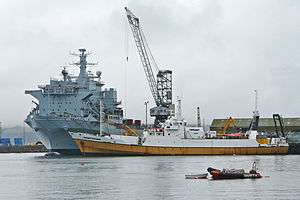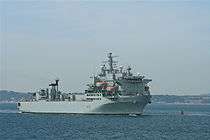RFA Argus (A135)
 RFA Argus off the coast of Devonport in 2007. | |
| History | |
|---|---|
| Name: | RFA Argus |
| Namesake: | HMS Argus |
| Launched: | 1981 |
| Acquired: | February 1982 by the MOD |
| Commissioned: | 1 June 1988 |
| Identification: |
|
| Motto: | Occuli Omnium (Eyes Of All) |
| Honours and awards: | As the MV Contender Bezant: Falkland Islands 1982. |
| Status: | in active service |
| Badge: |
 |
| General characteristics | |
| Type: | Aviation training / Casualty receiving ship |
| Displacement: | 28,081 tonnes |
| Length: | 175.1 m (574 ft 6 in) |
| Beam: | 30.4 m (99 ft 9 in) |
| Draught: | 8.1 m (26 ft 7 in) |
| Propulsion: | 2 × Lindholmen Pielstick 18 PC2.5V diesels, twin propellers; bow-thruster |
| Speed: | 18 knots (33 km/h) |
| Complement: |
|
| Sensors and processing systems: | Kelvin Hughes Ltd SharpEye navigation radar[1] |
| Armament: |
|
| Aircraft carried: | Three spots for Westland Sea Kings, CH47 Chinooks, Westland Merlins, WAH-64 Apache or Westland Lynx |
| Aviation facilities: | 1 Aircraft lift from Flight Deck to 4-Deck number 2 hangar, 4x hangars |
RFA Argus is a ship of the Royal Fleet Auxiliary operated by the MoD under the Blue Ensign. Italian-built, Argus was formerly the container ship MV Contender Bezant. The ship was requisitioned in 1982 for service in the Falklands War and purchased outright in 1984 for use as an Aviation Training Ship, replacing RFA Engadine. In 1991, during the Gulf War, she was fitted with an extensive and fully functional hospital to assume the additional role of Primary Casualty Receiving Ship. In 2009, the PCRS role became the ship's primary function.[2] Argus is set to go out of service in 2024.[3]
As the ship is armed, the Geneva Convention prevents her from being officially classified as a hospital ship.[4][5]
Design and facilities

After a four-year conversion at Harland and Wolff in Belfast the ship entered RFA service in 1988. Having been initially designed as a container ship, she would have been unstable when unloaded, making her motion at sea uncomfortable or even dangerous. Therefore, her superstructure is deliberately heavily built (weighing some 800 tons), and she has 1,800 tons of concrete ballast carried in former hatch covers, which have been inverted to form tray-like structures.[6]
Being a former container ship, Argus does not have a traditional aircraft carrier layout - the ship's superstructure is located forward, with a long flight deck aft. The ship has a small secondary superstructure approximately two-thirds of the way down the flight deck, containing the ship's exhaust funnel. This is used by small helicopters to simulate landing on the flight deck of a destroyer or frigate.
For the 1991 Gulf War Argus was fitted with a fully functional hospital, which has since been modified and extensively augmented with specialist equipment, providing 70 beds.[7] The ship is equipped with an intensive-care unit, and can provide medical x-ray and CT-scan services. Casualties can be quickly transferred from the deck directly into the assessment area. In recent years the ship's role as a Primary Casualty Receiving Ship has been considered her primary role rather than its aviation training duties.
In 2007 the ship was refitted with upgraded hospital facilities (replacing the forward aircraft lift with a ramp for emergency exit for hospital trollies and patients as well as two 50-man passenger lifts that lead to a new structure erected on the flight deck), generators and aviation systems (the ship is due to receive an upgrade to its night-vision capabilities enabling the use of WAH-64 Apache helicopters) to give an operational life until 2020.[8]
Service history
1988-1999
Argus entered service with the RFA in 1988, replacing RFA Engadine in the aviation training role. The ship deployed to the Persian Gulf in 1991 for service in the Gulf War (Operation Granby),[9] and also saw service in the Adriatic in 1993 and 1999 supporting British operations in Bosnia and over Kosovo respectively. During this period, Argus operated in part as a LPH. Her unsuitability for this role was a major factor in the commissioning of HMS Ocean.
2000-2011

During times of war RFA Argus acts as a floating hospital with two fully equipped wards and mortuary. The hospital was utilised in this way off the coast of Freetown in 2000-01, in support of British operations against the rebel West Side Boys.
A program to replace Argus called the Joint Casualty Treatment Ship (JCTS) was put on hold in December 2001 after passing initial approval. The Integrated Project Team (IPT) managing the project was subsequently disbanded in 2005. Argus was most recently stationed at her home port of Falmouth in Cornwall, England, though being an RFA ship means that she also uses the former naval dockyard on Portland in Dorset, England.
In 2003 Argus was deployed again to the Gulf as part of a 33 ship fleet to support a British amphibious assault of the Al-Faw Peninsula. Argus operated in its PCRS role.
In 2008 she deployed to the Middle East to act as a platform for Sea King ASaCs7 helicopters.
Argus operated as the Primary Casualty Reception Ship with British task group during Operation Telic.
In June 2011, Argus was operating in the Middle East around Yemen.[10]
In August 2011 Argus was at Falmouth and was a filming location for the 2013 film World War Z.[11][12] Originally she was to portray the fictional "USS Madison (LHD-19)" but in the final cut of the film, appeared as "U.N. Command Ship USS Argus."
2012-
In mid-May 2012 the vessel, with embarked forces from the Royal Marines and Fleet Air Arm, including an embarked Super Lynx helicopter and the newly formed Humanitarian and Disaster Relief Team, set sail for North America to support potential humanitarian operations during the hurricane season. Their primary mission will be to support the British Overseas Territories should they require assistance; they will also be maintaining the constant Royal Navy presence within the wider region. Before commencing her disaster relief mission the ship will engage in multinational exercises and celebrations commemorating the War of 1812 with units from the US Navy[13] as part of OpSail 2012.
2013
The ship has been used to train with the successor to the Lynx, the AgustaWestland Wildcat.[14]
2014
The ship participated in the annual Exercise Joint Warrior, practising Medical Evacuation and Treatment.[15][16]
On 8 October 2014, UK Foreign Secretary Philip Hammond announced that the RFA Argus would travel to Sierra Leone to assist with the 2014 Ebola outbreak.[17] On 30 October of the same year, the vessel docked in Sierra Leone.[18]
 RFA Argus entering Portsmouth Naval Base on 9 July 2010 with the crew lining the decks, and a Royal Marines band playing the ship into harbour.
RFA Argus entering Portsmouth Naval Base on 9 July 2010 with the crew lining the decks, and a Royal Marines band playing the ship into harbour. Another image of the same occasion.
Another image of the same occasion.
References
- ↑ https://www.gov.uk/government/news/new-navigation-radar-system-for-royal-navy
- ↑ "Casualty Ship (RFA Argus)". royalnavy.mod.uk. 2013. Retrieved 14 July 2013.
- ↑ https://www.gov.uk/government/uploads/system/uploads/attachment_data/file/484506/2015-10463_FOI_Request.pdf
- ↑ "World Wide Hospital Ships". Global Security. Retrieved 26 September 2015.
- ↑ "ADF Health" (PDF). Australian Department of Defence. Archived from the original (PDF) on 14 November 2012.
- ↑ Brown, D. K. & Moore, George (2003). Rebuilding the Royal Navy : Warship Design Since 1945. Chatham Publishing. p. 146.
- ↑ "Casualty Ship (RFA Argus)". Royal Navy. Retrieved 26 September 2015.
- ↑ "Refit of navy ship RFA Argus ends". BBC News. London: BBC. 12 May 2007. Retrieved 14 July 2013.
- ↑ "Select Committee on Defence – Written Evidence – Further memorandum from the Ministry of Defence". Parliamentary Debates (Hansard). House of Commons. 11 July 2007.
- ↑ "Marines on standby to evacuate Britons in Yemen". The Guardian. London: GMG. 7 June 2011. ISSN 0261-3077. OCLC 60623878. Retrieved 14 July 2013.
- ↑ Bentley, David (2 September 2011). "Navy crew tell of working with Brad Pitt for World War Z". blogs.coventrytelegraph.net. Retrieved 14 July 2013.
- ↑ "The Zombies are coming". historicalrfa.org. 2013. Retrieved 14 July 2013.
- ↑ "RFA Argus will be a MASF help". royalnavy.mod.uk. 25 February 2012. Retrieved 14 July 2013.
- ↑ "Navy Wildcat joins RFA Argus at sea for trials". Royal Navy. 18 October 2013. Retrieved 26 September 2015.
- ↑ http://web202.ssvc.com/news/articles/navy/2527 Archived 8 April 2014 at the Wayback Machine.
- ↑ "Medics practise life-saving skills". Ministry of Defence/Health. 7 April 2014. Retrieved 26 September 2015.
- ↑ "Ebola outbreak: UK sending 750 troops to Sierra Leone". BBC News. 8 October 2014. Retrieved 17 October 2014.
- ↑ "The Royal Navy's ship RFA Argus arrives in Sierra Leone". BBC News. 30 October 2014. Retrieved 26 September 2015.
External links
| Wikimedia Commons has media related to RFA Argus (A135). |